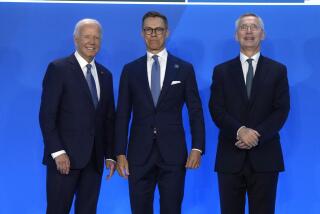U.S., 11 Nations Sign Pact for Space Station
- Share via
WASHINGTON — With the space shuttle now back in operation, the United States signed agreements with Japan and Canada and a consortium of nine European nations Thursday to cooperate in building, launching and using a $23-billion space station by the end of the century.
The timing of the ceremony was a “happy coincidence” with the successful launch of the shuttle Discovery earlier in the day, State Department spokeswoman Phyllis Oakley said in announcing the pact.
President Reagan committed the United States in 1984 to building a permanently manned civilian station, which he called Freedom. Understandings were reached with the three other partners in 1985, and the detailed cooperative agreements negotiated since then were signed here by Secretary of State George P. Shultz and representatives of the other 11 nations.
The United States will build most of the station and pay two-thirds of its cost. It will be launched piecemeal on 20 shuttle flights between 1995 and 1998 and assembled in a 250-mile-high orbit. The facility would be permanently manned beginning in late 1996, even though not yet fully completed, according to present plans.
“The significance of what we have just signed extends well beyond the immediate objective of space station cooperation,” Shultz said at the signing ceremony. “This project will be a shining symbol of the commitment of those who place a high value on political and economic freedom.”
The station will constitute the first permanent presence in space for the United States, and is considered a necessary first step to a human colony on the moon or a manned mission to Mars.
Study Weightlessness
In advance of such missions, officials said, the station would be used to study the effects of prolonged weightlessness on humans and to develop and test advanced technologies, including reliable, self-contained life-support systems.
The Soviet Union has put two types of “space stations” in orbit in the last 15 years. First were vehicles of the small Salyut series, which were visited on and off until 1985. Their successor is the Mir, or Peace, station, a cylinder about 55 feet long and 13 feet in diameter that has been permanently manned since it was launched 2 1/2 years ago.
Using these spacecraft, the Soviets have spent more than 4,700 man-days in space, three times more than the United States, and set other endurance records. On Mir, a cosmonaut recently set the latest mark for a man in orbit: 327 days.
The Freedom station will consist of an almost 500-foot-long horizontal boom, with four pressurized modules attached at its midpoint and huge solar panels at its extremities.
Estimated cost of the U.S. hardware is $16 billion, NASA official Margaret Finarelli said. Launching costs have not been fully calculated, she said, because of uncertainties about the number of shuttle flights that will be flown each year. But the sum is expected to be several billion more dollars.
Candidates Endorse Station
Both presidential candidates, Democrat Michael S. Dukakis and Republican George Bush, have endorsed the space shuttle . However, in the atmosphere of fiscal restraint likely to dominate the early years of the next administration, the space station project may suffer budgetary delays and stretched-out schedules.
The station has been designed to grow and evolve as requirements change. The current configuration “represents a starting point selected to best satisfy the broad range of scientific, engineering and commercial users,” according to a NASA-State Department statement.
The United States will build the station’s superstructure, its 75,000-watt power system, the living module, a scientific laboratory and a polar orbiting satellite.
Nine European nations, through the European Space Agency, will spend $4.2 billion on a second laboratory, another polar orbiting satellite and a satellite that will go out into a separate orbit unmanned but return every six months for servicing by the crew of the station.
The European hardware will be put into orbit by two launches of European Space Agency Arianne rockets. Participating nations are Belgium, England, Denmark, France, Italy, West Germany, the Netherlands, Norway and Spain. Japan will contribute a third $2 billion laboratory for the station and possibly could launch it aboard the H-2 rocket it is developing. Canada will supply a mobile servicing system for $1 billion.
Each participant will pay a proportionate cost of the estimated $1 billion to $1.5 billion annual cost of operating the station, according to Finarelli, who is head of NASA’s space station policy division.
Decisions affecting the civilian station will be based on “consensus” of the participants, Finarelli said.
More to Read
Sign up for Essential California
The most important California stories and recommendations in your inbox every morning.
You may occasionally receive promotional content from the Los Angeles Times.













